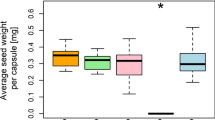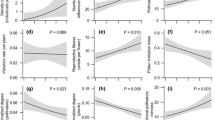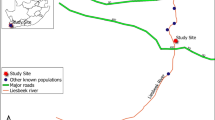Abstract
Habitat destruction has immediate consequences on biodiversity, whereas the effects of habitat degradation are slower and more subtle. Habitat quality and structure influence reproduction in rare plant species because changes in the local environment can disrupt sensitive plant–pollinator interactions. We used the self-compatible rare species Synthyris bullii to examine pollination and reproduction in response to woody encroachment, a type of degradation that occurs in prairies and savannas in the absence of fire. Additionally, we determined if autonomous selfing occurred more frequently than pollinator-mediated fertilization in degraded habitats. Infructescences from populations in open, semi-shaded, shaded habitats (i.e., different levels of encroachment) were collected to assess reproductive output (e.g., fruit/seed set) and fitness (i.e., germination). In addition, a pollinator exclusion treatment was conducted in these habitats to estimate pollen quantity (i.e., stigma pollen load). Pollinators contributed 32–57 % of pollen loads on average. We observed a significant increase in reproductive output associated with the pollinator treatment, even when the relative pollen contribution was small. Further, fruit and seed set were negatively affected by pollinator exclusion regardless of habitat type. We found evidence that pollen quantity/quality was lower in shaded habitats, which also played a role in lower fruit/seed set and germination compared to other habitats. Autonomous selfing does not occur at a sufficiently high rate, even in shaded habitats, to compensate for pollinator absence. As habitats degrade, reduced pollen quantity/quality and low autonomous selfing rates may contribute to the loss of rare species.


Similar content being viewed by others
References
Aizen MA, Harder LD (2007) Expanding the limits of the pollen limitation concept: effects of pollen quantity and quality. Ecology 88:271–281
Briggs JM, Knapp AK, Brock BL (2002) Expansion of woody plants in tallgrass prairie: a fifteen-year study of fire and fire-grazing interactions. Am Midl Nat 147:287–294
Busch JW (2005) The evolution of self-compatibility in geographically peripheral populations of Leavenworthia alabamica (Brassicaceae). Am J Bot 92:1503–1512
Cortes-Palomec AC, Ballad HE (2006) Influence of annual fluctuations in environmental conditions on chasmogamous flower production in Viola striata. J Torrey Bot Soc 133:312–320
Culley TM (2002) Reproductive biology and delayed selfing in Viola pubescens (Violaceae), an understory herb with chasmogamous and cleistogamous flowers. Int J Plant Sci 163:113–122
Curtis M, Chi K, Molano-Flores B (2013) Seed ecology of Synthyris bullii (Plantaginaceae), a rare endemic of the Midwestern USA. Botany 91:884–889
Dudash MR (1990) Relative fitness of selfed and outcrossed progeny in a self-compatible, protandrous species, Sabatia angularis L. (Gentianaceae): a comparison in three environments. Evolution 44:1129–1139
Dunn RR, Harris NC, Colwell RK, Koh LP, Sodhi NS (2009) The sixth mass extinction: are most endangered species parasites and mutualists? Proc Biol Sci 276:3037–3045
Engel EC, Irwin RE (2003) Linking pollinator visitation rate and pollen receipt. Am J Bot 90:1612–1618
Gleason HA, Cronquist A (1991) Manual of vascular plants of northeastern United States and adjacent Canada, 2nd edn. New York Botanical Garden, New York
Herrera CM (1995) Microclimate and individual variation in pollinators: flowering plants are more than their flowers. Ecology 76:1516–1524
Honnay O, Bossuyt B (2005) Prolonged clonal growth: escape route or route to extinction? Oikos 108:427–432
Honnay O, Jacquemyn H (2007) Susceptibility of common and rare plant species to the genetic consequences of habitat fragmentation. Conserv Biol 21:823–831
Johnston MO (1992) Effects of cross and self-fertilization on progeny fitness in Lobelia cardinalis and L. siphilitica. Evolution 46:688–702
Kearns CA, Inouye DW (1993) Techniques for pollination biologists. University Press of Colorado, Niwot
Kearns CA, Inouye DW (1997) Pollinators, flowering plants, and conservation biology. Bioscience 47:297–307
Kearns CA, Inouye DW, Waser NM (1998) Endangered mutualisms: the conservation of plant-pollinator interactions. Annu Rev Ecol Syst 29:83–112
Kennedy PG, Sousa WP (2006) Forest encroachment into a California grassland: examining the simultaneous effects of facilitation and competition on tree seedling recruitment. Oecologia 148:464–474
Kilkenny FF, Galloway LF (2008) Reproductive success in varying light environments: direct and indirect effects of light on plants and pollinators. Oecologia 155:247–255
Leach MK, Givnish TJ (1996) Ecological determinants of species loss in remnant prairies. Science 273:1555–1558
Malcolm JR, Liu C, Neilson RP, Hansen L, Hannah L (2006) Global warming and extinctions of endemic species from biodiversity hotspots. Conserv Biol 20:538–548
Maskell LC, Smart SM, Bullock JM, Thompson K, Stevens CJ (2010) Nitrogen deposition causes widespread loss of species richness in British habitats. Global Change Biol 16:671–679
McKinney AM, Goodell K (2010) Shading by invasive shrub reduces seed production and pollinator services in a native herb. Biol Invasions 12:2751–2763
McKinney ML, Lockwood JL (1999) Biotic homogenisation: a few winners replacing many losers in the next mass extinction. Trends Ecol Evol 14:450–453
McKone MJ, Ostertag R, Rauscher JT, Heiser DA, Russell FL (1995) An exception to Darwin’s syndrome: floral position, protogyny, and insect visitation in Besseya bullii (Scrophulariaceae). Oecologia 101:68–74
Moeller DA (2006) Geographic structure of pollinator communities, reproductive assurance, and the evolution of self-pollination. Ecology 87:1510–1522
Moeller DA, Geber MA, Eckhart VM, Tiffin P (2012) Reduced pollinator service and elevated pollen limitation at the geographic range limit of an annual plant. Ecology 93:1036–1048
Morgan JW (1999) Effects of population size on seed production and germinability in an endangered, fragmented grassland plant. Conserv Biol 13:266–273
Pauw A, Bond WJ (2011) Mutualisms matter: pollination rate limits the distribution of oil-secreting orchids. Oikos 120:1531–1538
Pimm SL, Raven P (2000) Biodiversity: extinction by numbers. Nature 403:843–845
Potts SG, Beismeijer JC, Kremen C, Neumann P, Schweiger O, Kunin WE (2010) Global pollinator declines: trends, impacts and drivers. Trends Ecol Evol 25:345–353
Rabinowitz D (1981) Seven forms of rarity. In: Synge H (ed) The biological aspects of rare plant conservation. Wiley, New York, pp 205–217
Ramsey M, Vaughton G (1998) Effect of environment on the magnitude of inbreeding depression in a partially self-fertile perennial herb (Blandfordia grandiflora, Liliaceae). Int J Plant Sci 159:98–104
Ratajczak Z, Nippert JB, Collins SL (2012) Woody encroachment decreases diversity across North American grasslands and savannas. Ecology 93:697–703
Rejmánek M, Rosén E (1988) The effects of colonizing shrubs (Juniperus communis and Potentilla fruticosa) on species richness in the grasslands of Stora Alvaret, Öland (Sweden). Acta Phytogeogr Suec 76:67–72
SAS Institute Inc. 2011. The SAS System Release 9.3. The SAS Institute, Inc. Cary, N.C
Shivanna KR, Tandon R (2014) Reproductive ecology of flowering plants: A manual. Springer, New Delhi
Slade AJ, Hutchings MJ (1987) The effects of light intensity on foraging in the clonal herb Glechoma hederacea. Ecology 75:639–650
Stuefer JF, Huber H (1998) Differential effects of light quantity and spectral light quality on growth, morphology and development of two stoloniferous Potentilla species. Oecologia 117:1–8
US Fish and Wildlife Service (1985) Endangered and threatened wildlife and plants; review of plant taxa for listing as endangered or threatened species. Fed Reg 50:39534–39583
Van Auken OW (2009) Causes and consequences of woody encroachment into western North American grasslands. J Environ Manag 90:2931–2942
Van Auken OW, Bush JK (1997) Growth of Prosopis glandulosa in response to changes in aboveground and belowground interference. Ecology 78:1222–1229
Van Kleunen M, Fischer M, Johnson SD (2007) Reproductive assurance through self-fertilization does not vary with population size in the alien invasive plant Datura stramonium. Oikos 116:1400–1412
Wilcock C, Neiland R (2002) Pollination failure in plants: why it happens and when it matters. Trends Plant Sci 7:270–277
Wilcove DS, Rothstein D, Dubow J, Phillips A, Losos E (1998) Quantifying threats to imperiled species in the United States. Bioscience 48:607–615
Wilson SD (1993) Belowground competition in forest and prairie. Oikos 68:146–150
Acknowledgments
We thank J. Mengelkoch, D. Abou-El-Seoud, M. Collins, F. Dandridge, M. Leja, S. Chavez, and H. Grant for assistance in field and laboratory work. In addition, thanks to the two reviewers who provided very thoughtful and extremely helpful comments to improve the quality of the manuscript. We thank organizations and private landowners who allowed us to conduct this research on their properties. This project was supported by the School of Integrative Biology at the University of Illinois, Illinois State Academy of Sciences, and the Illinois Wildlife Preservation Fund (Grant IDNR 11-018 W).
Author information
Authors and Affiliations
Corresponding author
Additional information
Communicated by Shayne Martin Jacobs.
Rights and permissions
About this article
Cite this article
Chi, K., Molano-Flores, B. Degradation of habitat disrupts plant–pollinator interactions for a rare self-compatible plant. Plant Ecol 216, 1275–1283 (2015). https://doi.org/10.1007/s11258-015-0507-3
Received:
Accepted:
Published:
Issue Date:
DOI: https://doi.org/10.1007/s11258-015-0507-3




